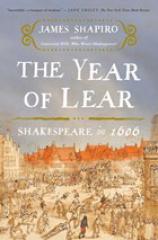The Year of Lear: Shakespeare in 1606
Review
The Year of Lear: Shakespeare in 1606
In 1606, William Shakespeare debuted “King Lear” and “Macbeth,”undoubtedly two of his greatest and most influential plays. While they are fascinating, harrowing and, above all, entertaining, James Shapiro, in THE YEAR OF LEAR, illustrates just how complex these plays are as they reflected the political and religious turmoil taking place in England that year.
It was just a few years into the reign of King James, the monarch responsible for the King James translation of the Bible, and tensions were running high in England. James hoped to unify England with his native Scotland to create a “Great” Britain, but unification seemed increasingly impossible. Religious differences were becoming ever more hostile and violent as Catholics tried to subvert the Protestant dominance, and the Protestants sought out the Catholic traitors who were often tortured and executed as criminals. New laws prohibiting certain words and phrases on stage and a resurgence of the plague contributed to a taut and dangerous atmosphere. Shakespeare, ever keen on unpacking such realities and exploring the corresponding psychology, had plenty of inspiration and material to draw from in the early 1600s. But like other playwrights and artists of the time, he had to carefully navigate the choppy waters of King James' days in power.
"Not just history and not quite textual criticism, THE YEAR OF LEAR is a richly detailed and well-explained portrait of England in 1606 and Shakespeare's role as a figure who both mirrored his culture for his audience and transformed the culture forever."
Shakespeare came into prominence as a playwright and actor under Queen Elizabeth, and many of his important plays are Elizabethan in language, style and content. But with the ascension of James to the throne, Shakespeare, as a royally sponsored and much admired playwright, had to exercise caution in what he wrote and staged so as to not offend the new ruler. King James' agenda differed from that of Elizabeth, so what was offensive and what was permitted shifted when he took the throne, and all of England had to adjust accordingly. The care with which Shakespeare had to tell the story of the assassination of a Scottish King in “Macbeth,”especially in light of several attempts on James' life, is detailed by Shapiro, as is his choice to return to classical subject matter to circumvent the prohibition on swearing to the Christian god on stage.
Shapiro does a fine job of placing Shakespeare, and a number of his Jacobean plays, into context and explaining some of the more interesting contextual details that helped make them popular in the 17th century and contribute to their popularity today. From terrorist attacks to demonic possession, from political failings to human foibles, Shakespeare captured the richness and complexities of life in England, before, during and after the year 1606, and Shapiro is a fantastic guide to this world and its legacy. He writes with an objective passion, making the book both academic and enjoyable to read. There are a few sections that are more challenging than others, but overall it is an engaging exploration of an important topic.
Not just history and not quite textual criticism, THE YEAR OF LEAR is a richly detailed and well-explained portrait of England in 1606 and Shakespeare's role as a figure who both mirrored his culture for his audience and transformed the culture forever. Shapiro's examination of this tumultuous year sheds light on European history, Shakespeare's literary contributions and what the Humanities have inherited from this astonishing moment in time. Recommended for history buffs, theater fans and bookworms alike.
Reviewed by Sarah Rachel Egelman on October 23, 2015
The Year of Lear: Shakespeare in 1606
- Publication Date: October 18, 2016
- Genres: History, Nonfiction
- Paperback: 384 pages
- Publisher: Simon & Schuster
- ISBN-10: 1416541659
- ISBN-13: 9781416541653





